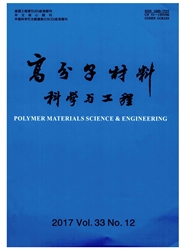

 中文摘要:
中文摘要:
制备了端羟基聚丁二烯-聚氨酯(HTPB-PU)和端羟基聚丁二烯-乙烯基三乙氧基硅烷-聚氨酯(HTPB-VTES-PU)两种聚氨酯膜。采用傅立叶变换红外光谱(FT-IR)、差示扫描量热仪(DSC)和透射电镜(TEM)分析表征了两种膜的结构,结果发现,HTPB-PU有两个玻璃化转变温度,其膜具有一定程度的微相分离结构;HTPB-VTES-PU有三个玻璃化转变温度,相比于HTPB-PU膜,HTPB-VTES-PU膜的微相分离程度更高。两种膜对1%丁醇/水体系渗透汽化分离结果表明,随HTPB-PU膜内异氰酸酯基/羟基(-NCO/-OH)的增加,膜的分离因子增加,丁醇通量略有增加,而总通量下降;对于HTPB-VTES-PU膜,随VTES添加量的增大,膜的丁醇通量略有增加,水通量增加显著,而膜分离因子下降;与HTPB-PU膜相比,HTPB-VTES-PU膜的丁醇通量增加,但分离因子下降。
 英文摘要:
英文摘要:
Hydroxyl-terminated polybutadiene-polyurethane(HTPB-PU) and HTPB-triethoxyvinylsilane-PU(HTPB-VTES-PU) membranes were prepared for pervaporation of n-butanol/water mixtures.The structure of HTPB-PU and HTPB-VTES-PU membranes were characterized by differential scanning calimetry(DSC),transmission electron microscopy(TEM).The results show that the HTPB-PU membrane possess the micro-phase separation structure,and the micro-phase separation structure of the HTPB-VTES-PU membrane is more significant with compared to HTPB-PU membrane.In 1% n-butanol aqueous solution pervaporation,the HTPB-PU membranes show that the separation factor increases continually with increase of the mole ratio of 4,4′-diphenylmethane diisocyanat(MDI)/HTPB(-NCO/-OH),when the ratio of-NCO/-OH is 2,the separation factor and total flux of the HTPB-PU membrane are 42.8 g/m2·h and 38.1 g/m2·h at 60 ℃,respectively.The total flux of the membrane increases,and the separation factor increases slightly followed by a dramatic decrease with the increase of VTES content for the HTPB-VTES-PU membrane.
 同期刊论文项目
同期刊论文项目
 同项目期刊论文
同项目期刊论文
 Effects of pluronic F127 on the polymorphism and thermoresponsive properties of PVDF blend membranes
Effects of pluronic F127 on the polymorphism and thermoresponsive properties of PVDF blend membranes Development of AgCl/poly(MMA-co-AM) hybrid pervaporation membranes containing AgCl nanoparticles thr
Development of AgCl/poly(MMA-co-AM) hybrid pervaporation membranes containing AgCl nanoparticles thr Synthesis of AgCl Nanoparticles in Ionic Liquid Microemulsion and Regulation of AgCl/poly(MMA-co-St)
Synthesis of AgCl Nanoparticles in Ionic Liquid Microemulsion and Regulation of AgCl/poly(MMA-co-St) Influence of Fe(2)O(3) Doping on Morphology and Photocatalytic Activity of TiO(2) Prepared by Adsorp
Influence of Fe(2)O(3) Doping on Morphology and Photocatalytic Activity of TiO(2) Prepared by Adsorp Regulation of AgCl in reverse microemulsion and its effect on the performance of AgCl/PEO-PPO-PEO/PM
Regulation of AgCl in reverse microemulsion and its effect on the performance of AgCl/PEO-PPO-PEO/PM Influence of modification of MWCNTs on the structure and performance of MWCNT-Poly(MMA-AM) hybrid me
Influence of modification of MWCNTs on the structure and performance of MWCNT-Poly(MMA-AM) hybrid me 期刊信息
期刊信息
